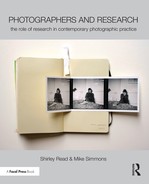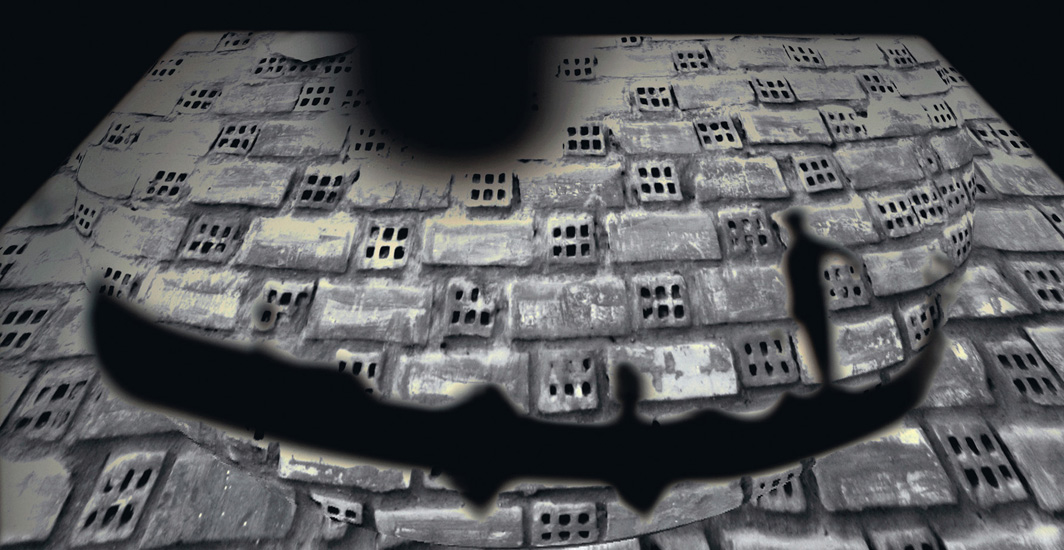Case Study
Maria Paschalidou
PhD student—De Montfort University, Leicester
HAVING COMPLETED AN UNDERGRADUATE programme in photography at the Focus School of Art and Photography in Athens in the mid-90s, I gained an MFA in photography from Columbia College Chicago some 12 years later. After more than 20 years developing my practice as a performance and installation artist, I’m now in the final phase of studying for a practice-based PhD at De Montfort University in the UK. So, my understanding of research has developed considerably over–long period of time, and I now see research very much as a creative process that exposes multiple possibilities; a process that requires openness to new pathways that may not be visible at the beginning of a project. I have learned to work on and to overcome many preconceptions about my subjects, and I have become familiar with the way hybrid forms of knowledge create a dynamic context for theory and practice to collide and evolve in new ways.
Believing that photography is not an objective medium, fiction has always been at the core of my practice. I consider myself a visual storyteller who uses photography and other lens-based media as tools for recording staged realities to question, critique, comment, rearrange or reconstruct the boundaries between fact and fiction and employ visual metaphors, fabricated environments, ephemeral constructions and participatory installations as a theatrical stage and a performative act.
I see art as a process of knowledge building and communication and through my work I explore issues of power and control where the body is a site of both socio-political and emotional conflict; the power agents that mediate in the construction of identity.
For example, notions of visibility and invisibility became central concerns in my work Bodies Under Investigation, a photographic installation of digital archival inkjet prints, accompanied by a short looped digital video of 3 minutes’ duration that explored how certain aspects of the inner self become visible through medical technology. This work refers to a hypothetical medical examination and uses specific types of numbering, text and diagrams used in medical imaging projected on the surface of the body to convey a certain viewing of the body.
My current research is built around the idea of ‘phantasmagoria’, a word used to describe the eighteenth- and nineteenth-century travelling theatrical extravaganzas that drew their themes from storytelling and narratives reflecting the era’s ‘visible’ concerns about death and the afterlife. A magic lantern as well as rear projections and theatrical effects were utilised to project depictions of ghosts and macabre dancing shows.
Initially my work concentrated on the production of a single visual spectacle adopting the practices and techniques of the old phantasmagoria shows in combination with contemporary visual technologies. However, during my research I realised that there were many different connotations of the word phantasmagoria and by examining the semantics of the word a definition emerged that the philosopher and cultural critic Walter Benjamin described as a ‘commodity culture’ implying a sociopolitical perspective, and I have used this interpretation to explore the current economic crisis in Greece.
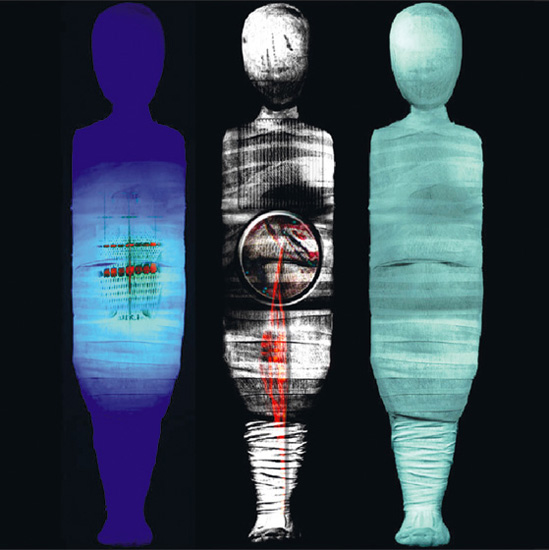
Detail from: Bodies Under Investigation.
Photograph by Maria Paschalidou, 2003.
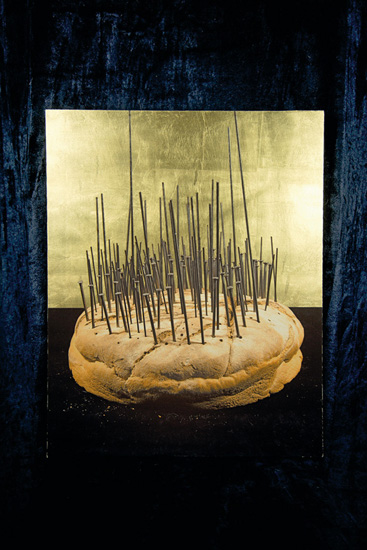
From: Biography of the Bread. Photography and video performance.
Photography by Maria Paschalidou, 2014.
I am particularly interested in investigating ways in which images, created using still photography and moving image, can be combined as a mechanism in the performance of personal narratives, to develop the dynamics in the trichotomy of artist—art work—audience. Over the years I have developed different art practices to explore ways of actively involving audiences in various stages of the art production. In retrospect, I would say that these practices generated outcomes that were evident on multiple levels. For example, they signified an embodied mobility; I as an artist-body left my studio and moved into the world. They signified the emergence of words and texts into the images, a fact that brought challenging tensions to the surface of the art. They signified certain displacements that led to the emergence of ‘unknown’ vocal audiences. I as an artist was no longer at the centre of my artwork. Finally, these art practices have signified movements in time and space and have transformed the audience into an artist and the audiences’ product into works of art that are contextual and situational. In Biography of the Bread, for example, the installation exposes the obsession with bread imposed by its fundamentality to the necessity of living, and the political games of lacking or being granted the right to it. The sounds of the installation mingle fragments of Byzantine ecclesiastic hymns with violent protest slogans in which the word ‘bread’ is being repeated.
Within the installation space, I suggest various ways of viewing and displaying static and moving images as well as encourage audience participation and immediate response to the works of art. The outcome has become a systematic production of visual statements that combine aesthetics and fiction with issues of power and control. Fiction is the tool with which I develop my concepts and my view of reality as a performative and transformative process. Fiction constitutes the library of my various translations of ‘reality’ and contains my artist’s perceptions of history, culture, memory and geography.
I have created a theoretical framework to investigate the implication of public speech as fiction and public space as performative and from this perspective the phantasmagoric becomes highly politicised and multi-vocal, as well as controversial, where the relations of power and aesthetics continuously pose questions of what is seen and what remains unseen, which voice is listened to and which is not.
My research is focused on various orchestrated participatory conditions where personal and public narratives can be visually exposed in performative and interactive ways. For example, Semiotics of the Phantasma was realised as a public performance at Eressos on the Greek island of Lesbos, in July 2014.
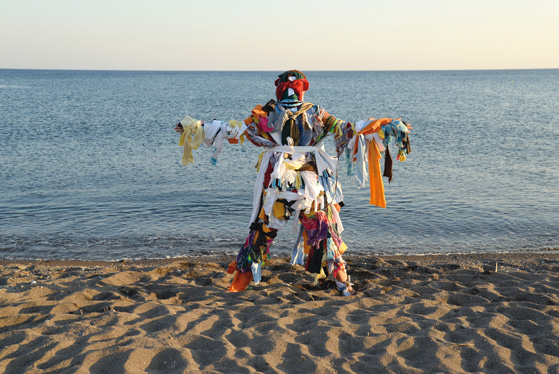
Still from the performance: Semiotics of the Phantasma.
Maria Paschalidou, 2014.
The performance draws on the local ritual of hanging personal items of clothing on the branches of wild olive trees, as a wish for healing from illness or injury. As the items weather and eventually fall to the ground the magical power of transfer is completed and the healing becomes validated. In this way personal anguish and fear are exposed to the public view creating a visual spectacle of multicoloured old and new clothing on the branches of the trees. Participants in Semiotics of the Phantasma contributed both at the preparation stages (cutting clothing into small pieces) and throughout the act of tying pieces of clothing over my body until I was fully covered by them. Creating staged conditions of visual imagery and audience participation in this way can yield different kinds of knowledge. In re-creating this particular ritual I was able to discern the nuanced ways in which the participants tied the pieces of clothing to my body; some were gentle while others were much more aggressive.
The performance in Eressos represented a collective simulation of a ritual that contemplates multiplicity and vanity or futility. Semiotics of the Phantasma explored performativity in photography while attempting to alternate between cultural custom and the dynamics of a collective experience expressed through the medium of the performance. This model of working is grounded in the creation of staged conditions and audiences’ direct involvement in different ways such as performing, writing, speaking, searching, listening or seeing, and in this way the artwork is constantly evolving and changing.
Interview by Mike Simmons
